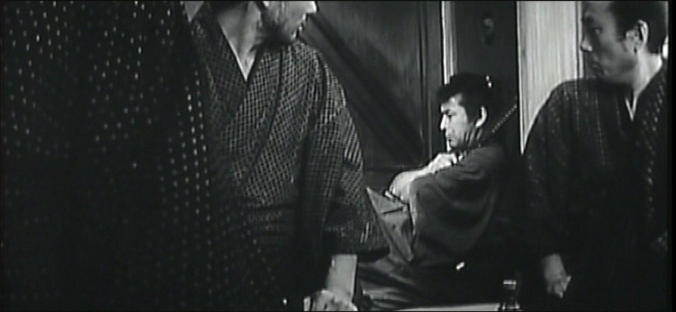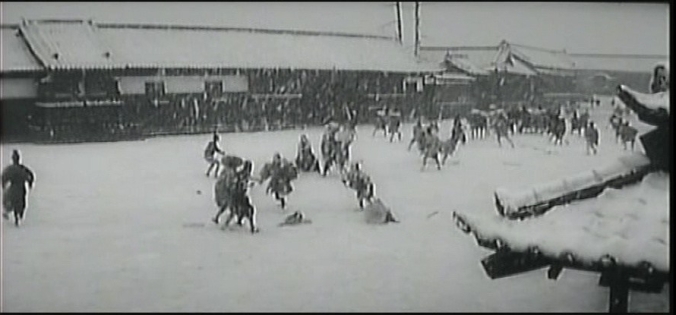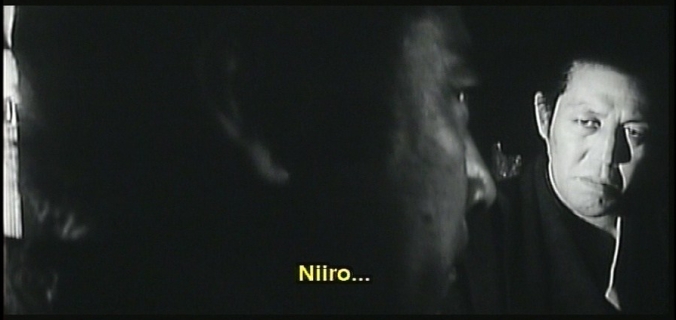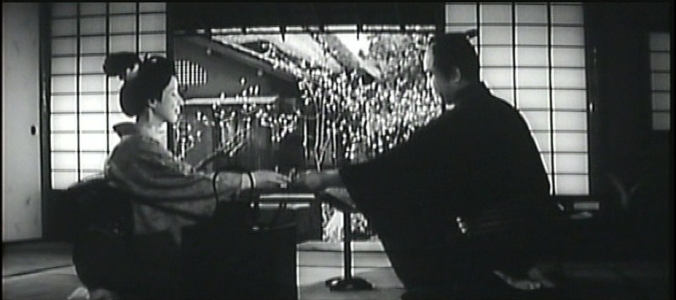 Based on a famous incident in Japanese history, Samurai Assassin assumes a certain amount of historical knowledge on the part of its audience, but don’t let that put you off. Most of the movie is fiction.
Based on a famous incident in Japanese history, Samurai Assassin assumes a certain amount of historical knowledge on the part of its audience, but don’t let that put you off. Most of the movie is fiction.
After the Americans arrived, the new Tokugawa Shogun was a child, so Chief Elder Ii actually ran the country and negotiated the (in)famous “Harris Treaty” that allowed Americans into the country. This necessarily brought him a great deal of internal opposition, which he proceeded to crush. Part of that opposition was to the foreigners, but part of it was also a matter of insulted samurai pride. Eventually that opposition evolved into an assassination plot against Ii, led primarily by the Mito clan, whose daimyo had been thrown off all the councils and put under house arrest. The movie begins as the Mito men are waiting for Ii to approach the Sakurada gate of the Edo castle. However, at that point, history begins to be fictionalized and the background becomes far less important than it initially seems to the non-Japanese viewer.
Ii doesn’t appear that day, so the Mito men immediately begin to search for a spy or traitor in their midst who must have warned him. They immediately turn to the only non-Mito man, Toshiro Mifune, who first appears in much the same way as he did in Sanjuro, slouching at the back almost asleep, with the added fillip of a close-up of him picking his nose. Here, he is a more realistic yojimbo, a ronin who ekes out a living as a “bodyguard” for a loan shark. He has no ties to the Mito clan, and unlike Raizo Ichikawa in Shinsengumi Chronicles, for example, he has no ideals. He is in his mid thirties and has long since lost any dreams of honor. He is in it purely for himself. If the plot succeeds, surely the Mito lord will give him a place, and if he actually manages to be the one to kill Ii, that will be a high and wealthy place. The investigation clears him, but he is still not trusted because his unknown father might mean he is not fully samurai, but he is also the best swordsman so he is given the job of killing the man suspicion next falls on, his only friend in the group.
Meanwhile Mifune has seen a woman who manages the teahouse where the gang meets and thinks she is someone else, so she begins her own investigation that tells us about the woman he lost and will eventually lead to the revelation of his true father.
It will eventually turn out that they had the wrong man, and anyway, Ii had merely decided for personal reasons not to come that day. But there is a later day that is so important he must come, and so finally we get to the famous battle of the 17 assassins and Ii’s 60 guards, which seems to be reproduced with some accuracy, including the pistol shot that wounds Ii.  The historical difference is that Mifune fights his way through to make the final kill and is last seen parading with the head on his sword, whereas the real killer immediately committed suicide. All of that is explained by a voice-over saying Mifune had been removed from all the records the day before the attack and by our seeing the copious stenographic record of the events blow into the moat during the battle.
The historical difference is that Mifune fights his way through to make the final kill and is last seen parading with the head on his sword, whereas the real killer immediately committed suicide. All of that is explained by a voice-over saying Mifune had been removed from all the records the day before the attack and by our seeing the copious stenographic record of the events blow into the moat during the battle.
As with so many of the early sixties chanbara, this is an extension of the idea that the samurai code was a lie, now adding that the recorded history itself was also a lie, as we have seen in movies as varied as Harakiri and Adauchi, to name only a pair.
This is, at least by release dates, the first movie Mifune made after his break with Kurosawa during Red Beard and the first of six that Mifune’s independent company would produce that were directed by Okamoto.* It is thus no particular surprise that Mifune’s character here seems initially to be modeled on Yojimbo, a comfortable character for him to slip back into after the nearly two years making Red Beard. Even so, it is hardly a simple reprise of the Yojimbo/Sanjuro character, for here he is insecure and desperate, not just for money but for a home, a clan, a fixed place in society. Though we often like to compare the samurai to the lone gunfighter of the American Western, they are utterly different. Both may take pride in their skill, their reputation, and their honor, but the samurai of film wanted and needed a place, a fixed spot in the society where he and everyone else knew exactly where and to whom he belonged. Even when the gunfighter is at last ready to “settle down,” he wants his own ranch in his own beautiful valley, not a job working for someone else. By contrast, it is the constant urge of the ronin in film after film to find a clan, a position, and to be part of the group again — to find a lord to serve. Now in his mid thirties, Mifune’s ronin here has lost all the cocky self-confidence of Yojimbo and, though not quite mad, is not far from it in his desperation to belong and to be respected again.
After the nose-picking at the beginning, the movie turns deadly serious, without the antic humor and near surrealist touches of most of Okamoto’s other films. Much of the movie is conversation and flashback, while Yunosuke Ito tries to keep the plan alive and find the spy.

Yunosuke Ito plotting and considering.
Ito’s character has a coldness that matches the snow covered exteriors. The whole film has that same kind of cold surface, coolly photographed and framed by Okamoto’s preferred cinematographer Hiroshi Murai. The final battle is a melee, but carefully contained with the space between the tea house and the entrance to the castle.
The Oedipal sub-plot used to provide a biography for Mifune’s character seems to me more distraction than really significant, though it provides another level of irony to the situation. But once all Mifune’s life history is sorted out, the film moves with increasing tension toward its bloody climax, helped enormously by Masaru Sato’s extremely sparse score.**
For some reason, the b & w chanbara makers who were beginning to challenge the old samurai Bushido myths also became interested in political assassination at about the same time. This joins films like Shinobi no mono, Shinsengumi Chronicles, Samurai Spy, The Great Killing, 13 Assassins, 11 Samurai, or Shinoda’s much more complicated Ansatsu, culminating in 1969’s Memoirs of Japanese Assassinations, all of which place assassination as a central part of Japanese history, often glossed over or re-written in the textbooks to provide a more positive look at the nation’s past.
As it happens, this was the first Okamoto movie I ever saw, and I thought it was the work of a great film-maker before I knew any of the rest of his movies, most of which are actually better. Though Okamoto and Kurosawa take different approaches and attitudes to their plots and presentation, Mifune could not have settled on a more congenial and talented “replacement” when he broke off with Kurosawa.

The friend at home with his wife. I include the capture of the scene precisely because it has nothing to do with the plot but nevertheless it is one of the quintessential shots of Japanese cinema and can be found in even the bloodiest of chanbara. It is almost impossible to find a Japanese movie not set in the apartments of Tokyo that does not include this shot in some form, and even in those movies there are variants that seem the same, with low camera, open door or screen, and one person meditating or two enjoying the view, always from opposite sides of the opening.
* Okamoto also directed Desperado Outpost, in which Mifune played a cameo, as well as two Mifune cops vs. gangsters movies before Mifune organized his own production company, which makes his collaboration with Mifune as extensive as Nakadai’s with Kobayashi or Raizo Ichikawa’s with Misumi.
** Sato’s variety and imagination as well as the amazing quality of the resulting films should rank him as one of the great film composers in world history and, if I get a chance, I will try to do a post about his work in general.
Pingback: Assassination / Ansatsu (1964) | Japanonfilm
Pingback: Samurai Rebellion / Joi-uchi: Hairyo tsuma shimatsu (1967) | Japanonfilm
Pingback: Sword of Doom / Daibosatsu toge (1966) | Japanonfilm
Pingback: Ironfinger / 100 Shots 100 Killed / (Hyappatsu hyakuchu 1965) | Japanonfilm
Pingback: Toshiro Mifune | Japanonfilm
Pingback: Memoirs of Japanese Assassins / Nihon ansatsu hiroku (1969) | Japanonfilm
Pingback: Tenchu / Hitokiri (1969) | Japanonfilm
Pingback: Four Days of Snow and Blood / 2.26 (1989) | Japanonfilm